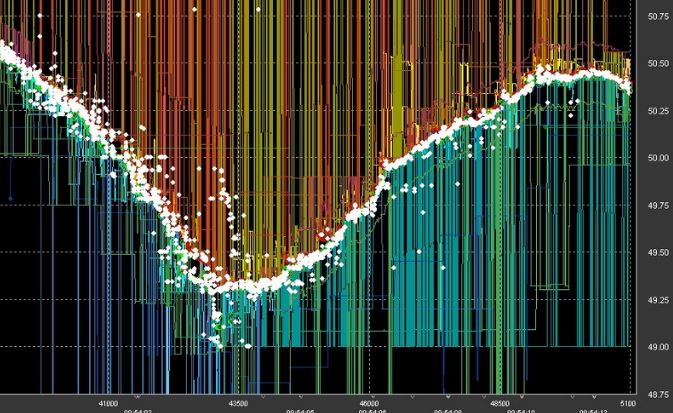High-Frequency Trading is one of the most discussed trading strategies to transform the securities industry (HFT). HFT is altering the securities landscape by utilizing high-speed computers and complex algorithms.
Computerized stock trading now accounts for an increasing proportion of total trading volume. HFT firms are increasingly acting as traditional market makers, maintaining two-sided markets on the majority of liquid stocks.
Financial professionals who understand how HFT works and how it affects equity markets will be well-equipped to answer questions about this hot topic.
Best Brokers for High-Frequency Trading in Canada
Broker Verified
CySEC, FCA
100% Deposit Bonus
USD 100
1:500
Broker Verified
FCA, ASIC, IIROC
Up to 20% Deposit Bonus
USD 100
1:500
Broker Verified
FCA, ASIC, CySEC
Demo of up to $100, 000
USD 100
1:500
Broker Verified
VFSC, ASIC
Low Spreads from 0.0
USD 10
1:500
What is high-frequency trading?
High-frequency trading, or HFT, is a trading strategy that employs powerful computer programs to execute a large number of orders in fractions of a second.
It analyzes multiple markets and executes orders based on market conditions using complex algorithms. Traders with the fastest execution speeds are typically more profitable than traders with slower execution speeds.

In addition to high order speeds, HFT is distinguished by high turnover rates and order-to-trade ratios. Tower Research, Citadel LLC, and Virtu Financial are some of the most well-known HFT firms.
Benefits of high-frequency trading
High-frequency trading, combined with large-volume trading of securities, enables traders to profit from even minor price fluctuations. It allows institutions to profit significantly from bid-ask spreads.
Trading algorithms are capable of scanning multiple markets and exchanges. It allows traders to find more trading opportunities, such as arbitraging minor price differences between different exchanges for the same asset.
HFT increases market competition because trades are executed faster, and the volume of trades increases significantly. Increased liquidity reduces bid-ask spreads, making markets more price-efficient.
A liquid market has less risk because there is always someone on the other side of a position. Furthermore, as liquidity increases, the price a seller is willing to sell for and the price a buyer is willing to pay will become closer together.
A stop-loss order, for example, ensures that a trader’s position closes at a specific price and prevents further loss.
Cons of high-frequency trading
One way that high-frequency traders can profit is simply by being faster than others. This may allow some traders to outperform other investors’ trades.
High-frequency traders may manipulate the market. This can be accomplished through spoofing, quote stuffing, wash trading, or tape painting.
Because high-frequency traders execute trades at such a rapid pace, things tend to go wrong quickly. As a result, if the trades are not carried out correctly, the results could be disastrous.
If trading algorithms send too many orders to a market venue at once, the exchange may be unable to process all of the trades immediately. As a result, the network may become slow or unavailable. It is similar to a denial of service attack against a website.
Differences between high-frequency trading and algorithmic trading
Algorithmic and high-frequency trading are frequently used in tandem. However, both the financial and technical environments are complex, and it is easy to mix up these terms.
Algorithmic or automated trading is also known as algo trading or black box trading. These automated trading solutions employ a variety of execution methodologies and algorithms. After a quick technical analysis, they can automatically place orders in the exchange or market.
The company can set specific trading instructions based on parameters such as volume, time, and market price using these pre-programmed algorithmic trading instructions.
Algo trading is ideal for dividing large purchases into smaller ones in order for investors to get the best price during a specific period. Smaller orders are frequently rewarded in a competitive market. Algorithmic trading has a few advantages for hedge funds, investment banks, and mutual funds.
Profitability of high-frequency trading
While HFT is available to all investors, advanced algorithms are required, which can only be obtained at a high cost. For new investors, high-frequency trading may not be the best option.
HFT is better suited for institutional investors who are prepared to deal with unexpected outcomes and market volatility.
Yes, HFT can be profitable, but in order to understand the market and gain experience, newcomers should stick to manual trading. As traders begin with day trading, they can gradually refine their strategies and progress to using HFT.
Critiques of high-frequency trading
HFT has received some criticism over the years.
By using algorithms and mathematical models to make critical decisions, this trading has largely replaced the broker-dealer relationship. As a result, the dean and human interaction have been removed from the equation.
These decisions are made in milliseconds, causing significant market movements. Furthermore, HFT enables larger corporations to profit from small traders.
Another type of criticism is ghost liquidity, which has allowed HFT to be available one second and then disappear the next. As a result, traders are unable to trade this type of liquidity.
Conclusion
If left unchecked, the proliferation of high-frequency trading may create the impression that the small investor cannot win.
Governments have attempted to rein in HFT firms by proposing a per-share trading tax. In 2012, Canada increased fees on market messages such as trades, order submissions, and cancellations, disproportionately impacting HFT firms due to their higher message volume.


